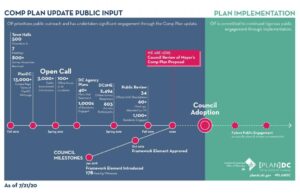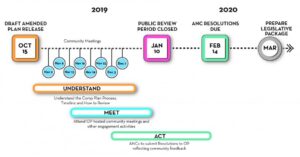—
DC’s Unaffordable “Affordable” Housing Problem
In this post, we will explore why DC’s “affordable” housing is not affordable for most working families and residents in DC.
In DC, “affordability” presents us a math problem that most people just don’t have the time or care to figure out. We hear the word “affordable” and everything must be all good. It’s not.
What is DC’s affordability problem?
The AMI is based on the incomes of working residents in the DMV region including the District of Columbia, Northern Virginia, and parts of Maryland.
In fact, the AMI includes incomes of some of the wealthiest people in the United States like residents in Fairfax County, VA and Montgomery County, MD. And more and more wealthy people are moving into the region and they are making more and more take home money every year.
Thus in 2023-2024, the AMI for our region is $152k/yr for a family of four. For a household of one (a single person), the AMI is $106k/yr.
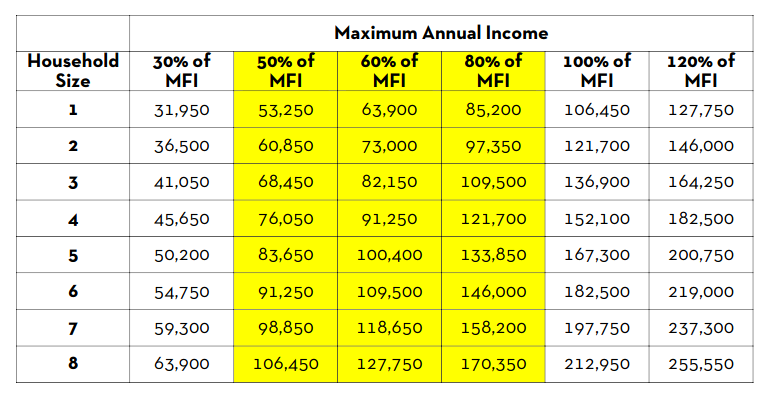
Source: Webpage, “2023-2024 Inclusionary Zoning Maximum Income, Rent and Purchase Price Schedule” at the DC Department of Housing and Community Development (DHCD) Wesbite, https://dhcd.dc.gov/publication/2023-2024-inclusionary-zoning-maximum-income-rent-and-purchase-price-schedule
There are three critical issues (among others) using DMV’s AMI to calculate DC’s “affordable” housing:
The AMI increases annually, thus DC’s overall affordability decreases each year.
- In 2017, a single person household making $62k/yr could qualify for one of DC’s “affordable” studio/one bedrooms. Now in 2023-24, an individual making $85k/yr can qualify for an “affordable” studio/one-bedroom housing unit in DC. Thus, the limited pool of “affordable” units becomes less and less accessible by lower-income residents.
Source: Testimony in Zoning Case 23-02, Exhibit No. 558, at page 4, by Save DC Public Land, citing to the DHCD affordability matrices from 2017 and 2022 contrasting annually decreasing affordability, https://app.dcoz.dc.gov/CaseReport/ViewExhibit.aspx?exhibitId=331135
The city is producing housing that is unaffordable for most people and non-existent for families, yet calling it all affordable housing.
- More than half of DC’s “affordable” units are for individuals making 80% of the AMI and by the math problem this mean “affordable” housing for individuals making $85k/yr.
- The vast majority of “affordable” units in DC are for single residents (studios/one-bedrooms), with almost no units for families of three or more.
Source: Report, “Inclusionary Zoning Annual Report for Fiscal Year 2022” published by the DC Department of Housing and Community Development (DHCD) and submitted to the DC Ctiy Council by DC Mayor Muriel Bowser on April 12, 2023, https://dhcd.dc.gov/node/1655696
The AMI doesn’t consider DC’s minimum wage or immense racial wealth gap.
- DC residents making the minimum wage are making about $33k/yr.
- The median household income for DC’s white residents, at $149k/yr, is over three times higher than the median income of DC’s Black residents, which is $50k/yr (pre-pandemic).
Source: Report, “D.C. Racial Equity Profile for Economic Outcomes” published by the DC Council Office on Racial Equity and the DC Policy Center dated January 2021, https://www.dcracialequity.org/dc-racial-equity-profile
Conclusion: DC’S “AFFORDABILITY” POLICY IS BROKEN!

DC’s Affordability Policy Based on the “AMI” is Broken
During the pandemic in 2022, GGW’s Libby Solomon covered how DC’s “affordability” index is based on the DMV’s ever increasing Area Median Income (“AMI”). See here: https://ggwash.org/view/81935/here-are-dcs-new-affordable-housing-income-limits-for-2021
However, what GGW consistently forgets to do is make some solid conclusions that may help the people struggling to stay in their hometown of DC. For example, using Ms. Solomon’s insights and links in her post above combined with the data points below (all cited and sourced to original DC government reports), we conclude:
DC’S AFFORDABILITY POLICY IS BROKEN
- Any “affordability” policy in DC that relies on the annually increasing Area Median Income (“AMI”) or functional equivalent Median Family Income (“MFI”) is broken;
- The policy and results become more and more broken as wealthy residents in the region become wealthier and as the DMV welcomes more and more new wealthy people.
- As the AMI continues to trend upwards, DC becomes less affordable and gentrification increases. This means the growing displacement of lower income residents which pushes up the AMI even faster fueling even more gentrification.
Looking at the AMI Numbers — DC’s affordability is becoming less and less affordable as the AMI increases annually
See the following data points over time:
Year; AMI
2011; 106,100
2013; 107,300
2015; 108,600
2018; 117,200
2020; 126,000
2021; 129,000
2022; 142,300
2023; 152,100
Conclusion:
Between 2013 to 2023, the AMI has increased $44,800, a 42.2% increase over ten years. This means the available pool of “affordable” units becomes less and less accessible by those who need it most as wealthier DC residents (those making more than two to three times the minimum wage) can qualify for DC’s limited supply of so-called “affordable” housing units.
The U.S. Census numbers show the results: A substantial number of lower income families and residents have been displaced from the city (60,000 Black residents over the past two decades) under DC’s current broken “affordability” policy based on the ever increasing “AMI.”
Ward One leads in Black displacement, with 25% of the Black population made gone over the past ten years as the AMI is really just starting to soar.
AMI Sources:
- 2011 — The Washington, DC area median income as determined by HUD for fiscal year 2011 is to equal $106,100. https://dhcd.dc.gov/sites/default/files/dc/sites/dhcd/publication/attachments/FY%202011%20DHCD%20Program%20Income%20and%20Rent%20Limits.pdf
- 2013 — The Washington, DC area median income, as determined by HUD for FY2013, is $107,300. https://dmv.dc.gov/sites/default/files/dc/sites/dhcd/publication/attachments/2013%20DHCD%20Rent%20and%20Income%20Limits.pdf
- 2015 — Maximum household income limits are based on the Washington Metropolitan Statistical Area 2015 Area Median Income (AMI) of $108,600 for a household of four, as published by the U.S. Department of Housing and Urban Development (HUD) on March 31, 2016. https://dhcd.dc.gov/sites/default/files/dc/sites/dhcd/publication/attachments/IZ%20Income%20Limits%202016.pdf
- 2018 — In FY2018, Median Family Income (MFI) for the Washington, D.C. metropolitan statistical area, as published annually by the U.S. Department of Housing and Urban Development (HUD), for a family of four was $117,200, and is adjusted for household size. https://dhcd.dc.gov/sites/default/files/dc/sites/dhcd/page_content/attachments/FY%202018%20Inclusionary%20Zoning%20Annual%20Report_0.pdf
- 2020 — The MFI for a household of 4, as published by the U.S. Department of Housing and Urban Development (HUD) on April 1, 2020, is $126,000. The limits are adjusted for household size in this schedule. https://dhcd.dc.gov/sites/default/files/dc/sites/dhcd/publication/attachments/2020.7.17%20IZ-ADU%202020%20Price%20Schedule.pdf
- 2021 — DC’s MFI in 2021 is $129,000 for a household of four. https://ggwash.org/view/81935/here-are-dcs-new-affordable-housing-income-limits-for-2021
- 2022 — Maximum Household Income Limits, rents and purchase prices are based on the Washington Metropolitan Statistical Area 2022 Median Family Income (MFI), previously referred to as Area Median Income (AMI), of $142,300 for a household of four, as published by the U.S. Department of Housing and Urban Development (HUD) on April 18, 2022. https://dhcd.dc.gov/publication/2022-2023-inclusionary-zoning-maximum-income-rent-and-purchase-price-schedule
- 2023 — Maximum Household Income Limits, rents and purchase prices are based on the Washington Metropolitan Statistical Area 2023 Median Family Income (MFI), previously referred to as Area Median Income (AMI), of $152,100 for a household of four, as published by the U.S. Department of Housing and Urban Development (HUD) on May 15, 2023. https://dhcd.dc.gov/publication/2023-2024-inclusionary-zoning-maximum-income-rent-and-purchase-price-schedule
Alex Baca, GGW: Let’s Talk About Housing and That’s It.

2024 Office of Planning & Office of Zoning Performance Oversight Highlights
- DC Office of Zoning (OZ) Agency Staff
https://www.youtube.com/live/pzjSzF2Ecls?si=0X5ewGKvSZ55UgJl&t=7374 - DC Office of Planning (OP) Agency Staff
https://www.youtube.com/live/pzjSzF2Ecls?si=hwGggDBlmXHA_Db3&t=14217
- Did OP/OZ's agency responses get at your problems and concerns, how? If not, why do you believe they didn't? And what's your follow up with these agencies or with the Committee to pursue the answers?
- Do you think we moved the needle in any way at these hearings for the people and for our interests in the city? How or why?
For me, the agencies and the city have no answers for (see attached print testimonials below for links to sources):
- 60,000 Black residents displaced in twenty years of #BuildingAsUsual
- Conservatively, there are 40,000 empty Class A housing units around the city right now — there is no luxury housing crisis (as if there ever was). We need affordable housing, social housing not luxury housing especially on public land.
- DC's definition of affordable housing IS NOT affordable for most people especially due to the immense racial wealth gap in DC.
- Parisa Norouzi, Empower DC
https://www.youtube.com/live/pzjSzF2Ecls?si=1owXIH1jsYXlJYNT&t=11994 - Anthony David, Racial Equity & The Environment, Empower DC
https://www.youtube.com/live/pzjSzF2Ecls?si=MX3-yc2Hj-IdLoCp&t=11822 - Andria Chatmon, Empower DC, Organizer
https://www.youtube.com/live/pzjSzF2Ecls?si=slp1rS2lTOvh-MGo&t=11347 - Sebrena Rhodes, Ivy City ANC
https://www.youtube.com/live/pzjSzF2Ecls?si=Xrm13Hi3GtnuE_zE&t=11136 - Shelly Repp, C100
https://www.youtube.com/live/pzjSzF2Ecls?si=qL1XRB4oWud7qipW&t=6076 - Chris Otten, DC4RD
https://www.youtube.com/live/pzjSzF2Ecls?si=AFHGwvzj3WcFBaz_&t=13138 - Historic Preservation, Rebecca Miller
https://www.youtube.com/live/pzjSzF2Ecls?si=_IderwN3JQ842u5h&t=13630 - Diedre Brown, Vice Chair NW Opportunity Partners (Ward 3) — Wisconsin Avenue Development Framework
https://www.youtube.com/live/pzjSzF2Ecls?si=3IqPQq4Irc_UpUFP&t=12473 - Parisa Norouzi on Map Amendments
https://www.youtube.com/live/pzjSzF2Ecls?si=GkpCcxQ5WOCPUrVf&t=6746

Colby King on Black Displacement from Washington D.C.
“The most destructive force to strike my native District of Columbia in my lifetime has been displacement: the forced removal of Black families and their community-binding activities and institutions from areas such as the Foggy Bottom and West End neighborhoods of Northwest D.C. and the southwest side of town. Displacement of thousands from places they had lived for generations to make room for new housing, better buildings and ultimately more affluent and privileged people.”
Opinion, “D.C. shoved Black neighborhoods aside. It’s still paying the price” by Colbert I. King, published in the Washington Post on January 19, 2024, https://archive.ph/5gxwK
The city's “poor folk [are being forced] out of their neighborhoods” by the city's “active role in development, selling or leasing publicly owned land, changing zoning laws, closing alleys and providing developers with inducements to construct new — or refurbish old — buildings … with resultant racial and class tensions.”
Opinion, “Quit the posturing in the Banneker-Shaw school dispute” by Colbert I. King on May 24, 2019 in the Washington Post, https://archive.ph/OSHig
“The city's growing tax base of middle-class couples and singles makes D.C. Mayor Anthony Williams giddy. The sight of “undesirable” neighborhoods being rapidly transformed into places where wealthier folks want to live makes Williams go weak in the knees. These changes are just what the mayor, his economic planners and his business friends ordered. Besides, there's no time for the displaced. The mayor's too busy with the National League of Cities and, when he's home, being wined and dined in glitzy downtown restaurants, Georgetown salons and the homes of folks he never thought he would meet when he was laboring as an Agriculture Department bureaucrat. The whole thing has turned his head. So what if booming property values and a richer downtown cultural life aren't doing much for renters or the evicted?”
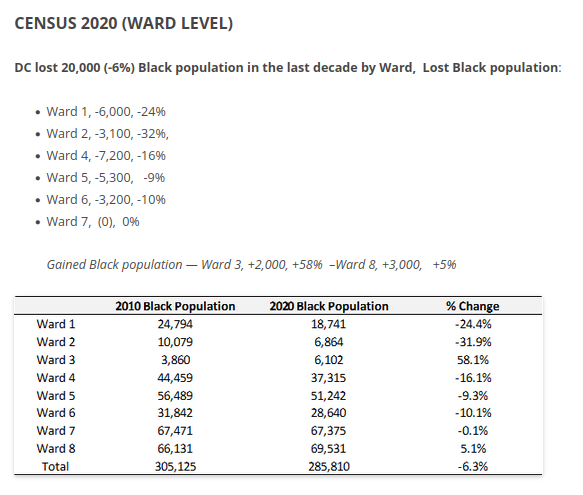
Sources:
- DC Office of Planning 2020 Census Reporting: https://planning.dc.gov/publication/2020-census-information-and-data
- DC Council staffer breaking down DC Census at the Ward Level:
https://twitter.com/Blaine_Stum/status/1425885669113712651 - Overall US Census Figures, Filter by State
https://www.census.gov/library/visualizations/interactive/race-and-ethnicity-in-the-united-state-2010-and-2020-census.html - DC Census Shocker: Ward 1 Profuse Black Displacement While Ward 3 Grows in Black Population http://www.dc4reality.org/updates/669
Press Alert: DC Neighbors Want Proper Notice Abt Controversial Rezoning Project (1617 U Street NW — Police & Fire Stations)
Wards 1 & 2, Washington, DC — The Mayor has applied to rezone 2-acres of public land at 1617 U Street NW to allow 10+ story buildings at the public site in an area surrounded by two- and three-story historic districts with rowhomes dating back to the 1800's.
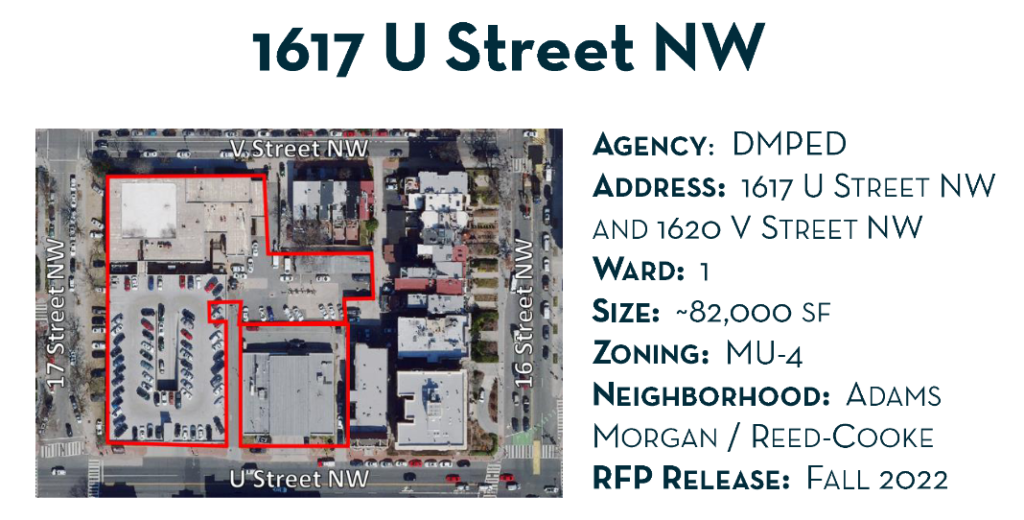
Despite the clamoring of opposition and desire for more engagement on the future of 1617 U Street, according to a neighbor's letter to the DC Council and a party's motion sent to the DC Zoning Commission showing that
the Mayor's Office of Planning and DC Office of Zoning have chosen to use outdated mailing lists that has left off numerous neighbors and properties from engagement, eliminating their opportunity to part of the zoning case and hearing this coming Monday, January 8, 2024.A motion filed with the Zoning Commission by neighbors says:
In all more than 40 different Property Owners within 200 feet of this site were not provided the legally required notice of the January 8, 2024 Hearing required under 11 DCMR, Subtitle Z, §402.1(d) nor did this Commission inform these 40+ Property Owners of “The requirements for participation as a party” and the importance of that status in a contested case, as required by 11 DCMR, Subtitle Z, §402.2. This upzoning is the prelude to DMPED’s attempt to have a massive 11 story, 650 unit apartment building constructed on this site. Failure to grant Property Owners their due process rights under the Subtitle Z in this contested case, is not only fundamentally wrong but will likely cause extensive and unnecessary future litigation.
Neighbors are asking the Zoning Commission to rule on the motion asking for postponement until proper and full notice is sent to all affected neighbors per the zoning regulations.
### ###
From: Arlene Feskanich <feskanicha@gmail.com>
Date: Fri, Jan 5, 2024 at 1:20 PM
Subject: Office of Zoning Case 23-02: Joint Motion to Continue January 8, 2024 Hearing Due to Failure to Properly Notify All Property Owners Within 200 Feet & Mailing List Used to Serve Property Owners Was from 2022 (or Earlier)
To: <abonds@dccouncil.gov>, bnadeau@dccouncil.gov <bnadeau@dccouncil.gov>, <bpinto@dccouncil.gov>, <callen@dccouncil.gov>, <chenderson@dccouncil.gov>, <jlewisgeorge@dccouncil.gov>, <kmcduffie@dccouncil.gov>, mfrumin@dccouncil.gov <mfrumin@dccouncil.gov>, <pmendelson@dccouncil.gov>, <rwhite@dccouncil.gov>, <twhite@dccouncil.gov>, <vgray@dccouncil.gov>, <zparker@dccouncil.gov>
CC: Arlene Feskanich <feskanicha@gmail.com>, Edward Hanlon <ed.hanlon.3@gmail.com>, Gregory Adams <adams.gregory1@yahoo.com>, Randy Jones <rjj0302@gmail.com>, Schellin, Sharon (DCOZ) <sharon.schellin@dc.gov>
From: ed.hanlon.3@gmail.com <ed.hanlon.3@gmail.com>
Sent: Thursday, January 4, 2024 4:01 PM
To: 'Daniel.Lyons@dc.gov' <Daniel.Lyons@dc.gov>; 'Jennifer.Steingasser@dc.gov' <Jennifer.Steingasser@dc.gov>; 'Joel.Lawson@dc.gov' <Joel.Lawson@dc.gov>; 'dcoz@dc.gov' <dcoz@dc.gov>; 'Brian (OAG' <Brian.Schwalb@dc.gov>; 'oag@dc.gov' <oag@dc.gov>; 'Alexandra (OAG' <Alexandra.Cain@dc.gov>; 'Lily (OAG' <lily.bullitt@dc.gov>; 'Maximilian.Tondro@dc.gov' <Maximilian.Tondro@dc.gov>; 'Niquelle.Allen@dc.gov' <Niquelle.Allen@dc.gov>; 'Johnnie.Barton2@dc.gov' <Johnnie.Barton2@dc.gov>; 'ashley.cooks@dc.gov' <ashley.cooks@dc.gov>; 'odca.mail@dc.gov' <odca.mail@dc.gov>; 'jlewisgeorge@dccouncil.gov' <jlewisgeorge@dccouncil.gov>; 'oca.eom@dc.gov' <oca.eom@dc.gov>; 'dmped.eom@dc.gov' <dmped.eom@dc.gov>; 'planning@dc.gov' <planning@dc.gov>; 'sharon.schellin@dc.gov' <sharon.schellin@dc.gov>; 'DCOZ – ZC Submissions (DCOZ' <DCOZ-ZCSubmissions@dc.gov>; '1b@anc.dc.gov' <1b@anc.dc.gov>; '2B@anc.dc.gov' <2B@anc.dc.gov>
Subject: Joint Motion to Continue January 8, 2024 Hearing Due to Failure to Properly Notify All Property Owners Within 200 Feet & Mailing List Used to Serve Property Owners Was from 2022 (or Earlier)
JOINT MOTION OF DUPONT CIRCLE CITIZENS ASSOCIATION,
HOMEOWNERS WITHIN 200 FEET OF LOTS 826 AND 827 AND RANDALL JONES
REQUESTING THE COMMISSION CONTINUE THE JANUARY 8, 2024 HEARING DUE TO
FAILURE TO PROPERLY NOTIFY ALL PROPERTY OWNERS WITHIN 200 FEET
—- continued on the record —-
———– click link above ——–
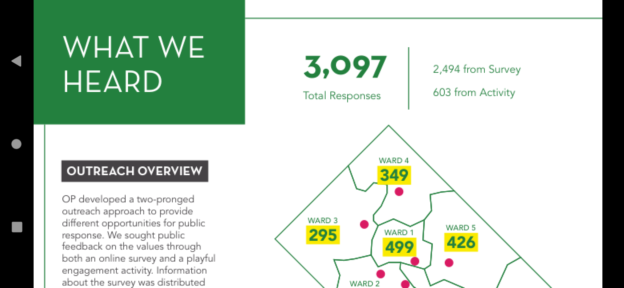
Interesting comparison… Community Surveys
—
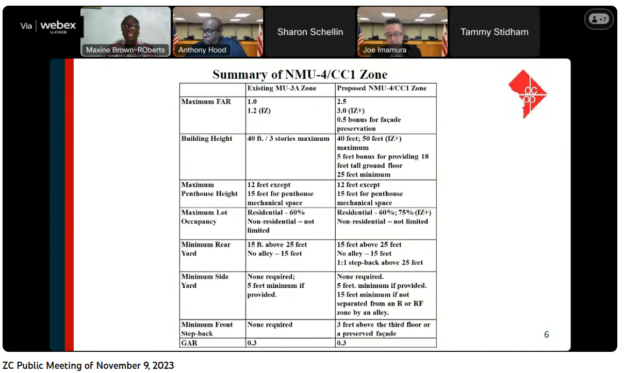
Fwd: News Alert: DC Zoning Commission Waives Notice Requirements & Forges Ahead to a “Rulemaking” Hearing (in 2024) About The Future of the Chevy Chase Commons
DC Zoning Commission Waives Notice Requirements & Forges Ahead to a “Rulemaking” Hearing (in 2024) About The Future of the Chevy Chase Commons
Ward 3, Washington, DC, Nov. 9, 2023 – In a stunning rebuke to written public comments asking for postponement, including a letter from three Chevy Chase ANC Commissioners asserting that setdown of the Office of Planning's proposed new zones should not proceed “without the expressed view of ANC3/4G,” the DC Zoning Commission chose to waive notice requirements and to set down ZC Case No. 23-25 as “rulemaking.”
This decision by the Zoning Commission inches the mayor closer to privatizing public property currently occupied by the community center, library, and outdoor recreation facilities, even as ANC 3/4G continues to seek feedback from the community about the future of the site, via an ANC-devised survey. The majority of the members of the Zoning Commission are appointed by the mayor; and the Commission generally hews to the directives of the mayor's Office of Planning.
Zoning Commissioner and Vice Chair Robert Miller acknowledged “technical defects” but averred that “people know about this case going forward”. Chair Hood won unanimous approval from his fellow commissioners to waive the Commission's noticing requirements and procedures.
Chair Hood explained he was aware of ANC3/4G's community survey, to close on November 12, and stated that the Zoning Commission would take into account what the ANC drew from the survey.
The two custom zones for which OP is seeking approval (one for the site of the Chevy Chase Commons; and the second for the other Connecticut Avenue-facing lots between Livingston and Chevy Chase Circle) enable any projects that meet that custom zone criteria to proceed directly to permitting, thus eliminating future zoning hearings for developers and community members to engage in negotiations. Similarly, a “rulemaking” case is not subject to the vigorous public input that can take place with a “contested” case. These preemptive zoning actions are consistent with far-reaching text amendments proposed by the Office of Planning that squelch public participation in the zoning process (pending Zoning Case 22-25). — Andrea Rosen
Homelessness Grows At Record Pace Even As Oversupply Plagues High-End Multifamily Market
The rising cost of housing is putting more Americans on the street than ever before.
The homeless population in the U.S. has increased by 11% this year compared to 2022, according to a preliminary data analysis by The Wall Street Journal. Though the U.S. Department of Housing and Urban Development plans to release finalized data later this year, anything close to the WSJ's preliminary figure would represent a record since HUD began its current method of data collection in 2007.
The previous biggest single-year jump in homelessness was 2.7% from 2018 to 2019, excluding the 2022 increase driven by a pandemic-affected undercount in 2021, the WSJ reports. The data collection method used by the WSJ and HUD, called a point-in-time count, routinely undercounts the true homeless population, but this year's preliminary figure counted at least 577,000 unhoused persons.
The single biggest driver of homelessness in the U.S. is rising housing costs, which persist even as inflation recedes from the rest of the economy. Shelter accounted for 90% of total inflation in July's consumer price index. Despite increased attention on the risk of homelessness for vulnerable populations, funding for support programs remains low.
Unhoused populations cluster in U.S. cities, but at varying rates. Denver's point-in-time count showed a 32% increase in homelessness, while Los Angeles recorded a 10% jump this year, the WSJ reports. New Orleans showed a 15% increase in homelessness, reversing improvements made in the first two years of the pandemic.
Despite affordable housing's scarcity, the overall supply of rental housing is increasing at a record pace, suppressing rent growth and imperiling some landlords that took out loans when the market was at its hottest. But that increased supply is vastly overweighted to the most expensive units, CoStar reports.
For at least seven consecutive quarters, over 70% of new U.S. apartment deliveries have been in the two most expensive rent tiers, CoStar reports. That trend is poised to continue this year, when over 500,000 more apartments are expected to deliver.
In those two most expensive tiers, rents decreased in the second quarter and vacancy rose to 9.1% after hitting a low of 6.5% in 2021, CoStar reports. In the Sun Belt, the reversal has been the most dramatic, with rents in the two most expensive tiers decreasing 4.5% in Austin, Texas, in Q2.
Contact Matthew Rothstein at matt.rothstein@bisnow.com


